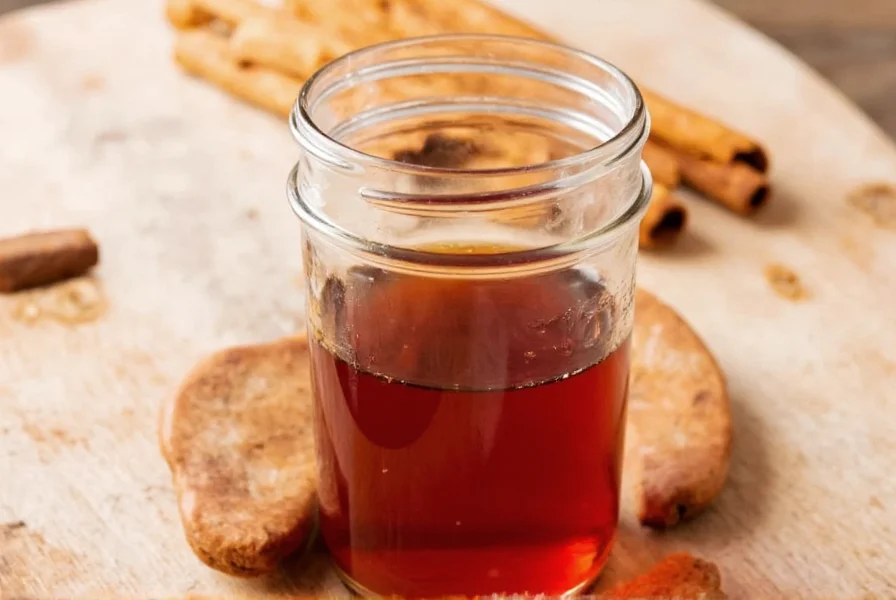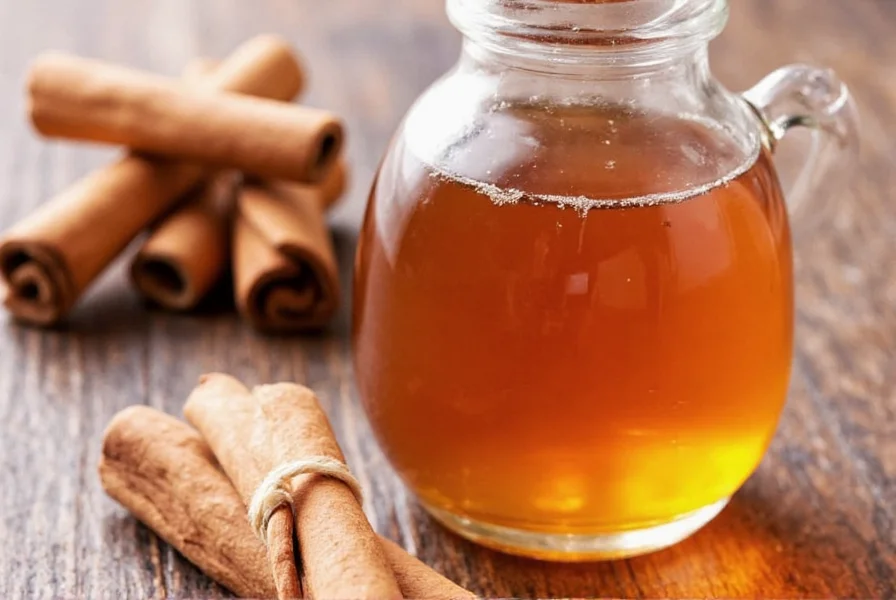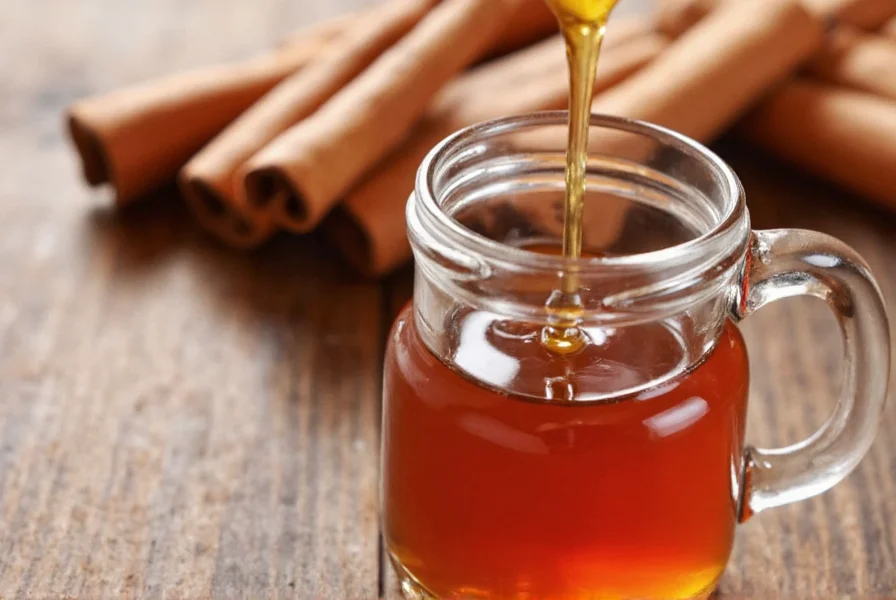Cinnamon syrup transforms ordinary beverages and dishes with its rich, warming flavor. Unlike artificial flavorings, homemade cinnamon syrup captures the complex essence of real cinnamon through a straightforward infusion process. This pantry staple has gained popularity among home baristas, mixologists, and bakers seeking to elevate their creations with natural spice notes.
What Exactly Is Cinnamon Syrup?
Cinnamon syrup, sometimes called cinnamon simple syrup, is a flavored simple syrup where cinnamon serves as the primary infusion ingredient. The syrup base—typically a 1:1 ratio of water to sugar—acts as a solvent that extracts cinnamon's essential oils and flavor compounds during gentle heating. The resulting liquid carries both the sweet profile of simple syrup and the distinctive spicy warmth of cinnamon.
Unlike cinnamon extract which uses alcohol as a base, cinnamon syrup maintains the viscosity and sweetness of traditional simple syrup while delivering authentic spice flavor. This makes it particularly valuable for sweetening beverages without diluting their strength, as the syrup integrates smoothly without the separation issues that can occur with oil-based extracts.
Practical Applications in Beverages and Cooking
Cinnamon syrup shines in numerous culinary applications, particularly where consistent flavor distribution matters. For coffee enthusiasts, adding half an ounce of cinnamon syrup to lattes or cold brew creates a naturally sweetened spice profile that surpasses powdered alternatives. The syrup dissolves completely in both hot and cold liquids, making it ideal for iced coffee preparations where granulated spices would settle.
In mixology, cinnamon syrup serves as a foundational element for seasonal cocktails. Bartenders favor it for crafting balanced drinks like spiced Old Fashioneds or cinnamon whiskey sours where precise sweetness and flavor control are essential. The syrup's liquid form allows for accurate measurement compared to estimating with ground spices.
| Application | Recommended Amount | Best Paired With |
|---|---|---|
| Coffee/Espresso | 0.5-1 oz per 8oz beverage | Oat milk, vanilla, nutmeg |
| Cocktails | 0.75-1.5 oz per drink | Bourbon, rum, apple cider |
| Dessert Toppings | 1-2 tbsp per serving | Pancakes, ice cream, fruit salads |
Creating Perfect Homemade Cinnamon Syrup
Mastering how to make cinnamon syrup at home requires minimal equipment and delivers superior results to store-bought versions. The traditional cinnamon simple syrup ratio uses equal parts water and sugar with cinnamon sticks as the flavoring agent. Avoid ground cinnamon, which creates sediment and an uneven texture.
Basic cinnamon simple syrup recipe:
- 1 cup water
- 1 cup granulated sugar
- 3-4 cinnamon sticks (6 inches each)
Combine all ingredients in a saucepan. Bring to a gentle simmer over medium heat, stirring until sugar dissolves completely. Reduce heat to low and continue simmering for 10-15 minutes to extract maximum flavor. Remove from heat, cover, and let steep for an additional 30 minutes. Strain through a fine-mesh sieve into a clean glass bottle or jar. Cool completely before sealing.

Customizing Your Cinnamon Simple Syrup
Variations on the basic recipe allow for personalized flavor profiles. For a deeper spice complexity, add one whole star anise or a few whole cloves during the simmering process. Citrus enthusiasts might enjoy incorporating an orange peel strip for bright contrast to the warm cinnamon notes.
Those seeking cinnamon syrup for cocktails with enhanced complexity often use demerara sugar instead of white sugar, which contributes subtle molasses notes that complement spirits like rum and bourbon. For stronger cinnamon intensity without bitterness, increase the cinnamon stick quantity rather than extending the steeping time beyond 45 minutes total.
Proper Storage and Shelf Life Considerations
Understanding cinnamon syrup shelf life ensures both safety and optimal flavor. When stored in a sterilized glass container with a tight-sealing lid, homemade cinnamon syrup remains fresh for 2-3 weeks in the refrigerator. The high sugar content acts as a natural preservative, but the absence of commercial stabilizers means refrigeration is essential.
Watch for signs of spoilage including cloudiness, mold growth, or off odors. If using fresh citrus elements in your syrup, consume within 10 days for best quality. For extended storage, freeze the syrup in ice cube trays then transfer the frozen cubes to airtight bags—this homemade cinnamon syrup storage method preserves flavor for up to 3 months.
Cinnamon Syrup in Culinary Creations Beyond Beverages
While popular in drinks, cinnamon syrup's versatility extends to numerous culinary applications. Drizzle it over oatmeal or yogurt for instant flavor enhancement without grainy texture. Incorporate into marinades for chicken or pork where the sugar content promotes beautiful caramelization during cooking.
Bakers appreciate cinnamon syrup as a brush-on finish for cakes and pastries that adds moisture and flavor without making surfaces soggy like liquid extracts might. For a sophisticated dessert presentation, reduce additional syrup by half to create a glossy, concentrated drizzle that intensifies both visual appeal and cinnamon flavor.

Comparing Flavor Delivery Methods
Understanding the differences between cinnamon syrup vs cinnamon extract helps determine the right choice for specific applications. Extracts deliver concentrated flavor with minimal liquid, making them ideal for baking where moisture content matters. Syrups, however, provide both flavor and sweetness in one addition, simplifying recipes and ensuring even distribution.
For cold applications like iced coffee or chilled cocktails, syrup outperforms extracts which can sometimes separate in cold temperatures. The sugar content in syrup also helps carry flavor compounds more effectively in cold liquids, creating a more integrated taste experience than extracts alone.
Frequently Asked Questions
Can I use ground cinnamon instead of sticks for syrup?
While possible, ground cinnamon creates sediment and can make the syrup cloudy. Cinnamon sticks provide cleaner extraction without particulate matter. If using ground cinnamon, strain multiple times through cheesecloth and expect a shorter shelf life due to potential bacterial growth in the fine particles.
Why does my homemade cinnamon syrup crystallize?
Crystallization occurs when sugar molecules re-form crystals, often due to improper heating or contamination. Ensure sugar dissolves completely during initial heating, avoid stirring after sugar dissolves, and use distilled water to prevent impurities from triggering crystallization. If crystallization occurs, gently reheat the syrup with a small amount of water or lemon juice.
How can I adjust cinnamon syrup sweetness for dietary needs?
For reduced sugar versions, try a 2:1 water-to-sugar ratio instead of equal parts. Sugar substitutes generally don't work well as they don't provide the same preservation qualities. For sugar-free options, consider cinnamon-infused simple syrup alternatives using monk fruit sweetener, though these will have different storage requirements and flavor profiles.
What's the best cinnamon variety for syrup making?
Ceylon cinnamon (often called 'true cinnamon') offers a more delicate, complex flavor preferred by professional chefs, while Cassia cinnamon provides a stronger, more familiar 'cinnamon' taste most people recognize. Cassia works well for bold applications like coffee syrups, while Ceylon shines in more delicate preparations like dessert sauces.
Can I use cinnamon syrup as a substitute for maple syrup?
Yes, cinnamon syrup makes an excellent substitute for maple syrup in many applications, particularly where a spiced profile complements the dish. It works especially well on pancakes, waffles, and French toast. Note that the flavor profile differs significantly—cinnamon syrup lacks maple's distinctive earthiness but adds warming spice notes that pair beautifully with autumnal dishes.











 浙公网安备
33010002000092号
浙公网安备
33010002000092号 浙B2-20120091-4
浙B2-20120091-4